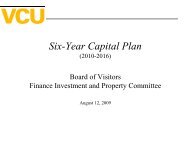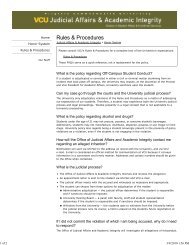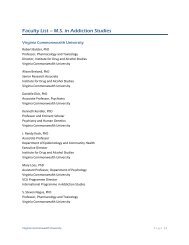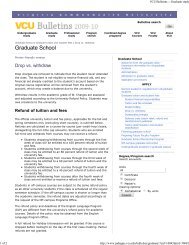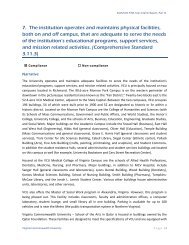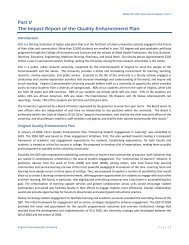4. The institution identifies expected outcomes, assesses the extent ...
4. The institution identifies expected outcomes, assesses the extent ...
4. The institution identifies expected outcomes, assesses the extent ...
You also want an ePaper? Increase the reach of your titles
YUMPU automatically turns print PDFs into web optimized ePapers that Google loves.
SACS/COC Fifth-Year Interim Report, Part III.<br />
In working with faculty in <strong>the</strong> School of <strong>the</strong> Arts in <strong>the</strong> coming months to streng<strong>the</strong>n <strong>the</strong>ir measures, <strong>the</strong><br />
Office of Assessment will build on a known strength: <strong>The</strong> assessment reports demonstrate that <strong>the</strong>re<br />
are numerous existing opportunities to assess student learning objectives in <strong>the</strong> School of <strong>the</strong> Arts<br />
through critiques, juried competitions, exhibitions, presentations, performances and recitals, portfolio<br />
reviews, and capstone projects. Thus, where scoring rubrics are not already in place, <strong>the</strong> Office of<br />
Assessment will encourage faculty in <strong>the</strong> School to articulate <strong>the</strong>ir criteria for evaluating <strong>the</strong>se key<br />
student work products. Those criteria will be used to develop and implement rubrics. <strong>The</strong> next step will<br />
be to incorporate multiple raters, where possible, and to evaluate inter-rater reliability.<br />
Although measurement is a challenge for <strong>the</strong> School overall, programs in Art Education and in Music<br />
have strong assessment plans with solid measures. In <strong>the</strong> Music, B.A., program, for example, one of <strong>the</strong><br />
measures includes a series of four juried proficiency exams to demonstrate performance skills on<br />
students’ major instruments. As <strong>the</strong> Music Program notes:<br />
Jury exams are conducted before a panel of multiple music faculty (minimum of two) who are<br />
specialists in <strong>the</strong> student's area of performance. Scores are averaged among all jurors. A minimum<br />
threshold standard must be met to pass each level jury. Students who do not pass at least one<br />
level in a two-semester sequence are not permitted to continue as music majors. Level<br />
requirements are detailed in documents accompanying or included within <strong>the</strong> Applied Music<br />
syllabi for each student. Each area faculty (Winds, Voice, etc.) regularly reviews and coordinates<br />
<strong>the</strong> level requirement details (with some variance by instrument within departmental guidelines)<br />
to address technical skills, repertory, sight-reading, rehearsal skills, keyboard competency,<br />
ensemble approaches, and ultimately students’ expressiveness and artistry.<br />
Faculty in <strong>the</strong> School are strongly committed to continuous improvement of student learning. <strong>The</strong><br />
Communication Arts, B.F.A. program, in reflecting on its findings for 2008-2009, describes this<br />
dedication to enhancing student learning:<br />
It is in <strong>the</strong> nature of <strong>the</strong> creative process and <strong>the</strong> work that we improve on a continuous basis. We<br />
are rarely completely satisfied. <strong>The</strong> fundamental impulse that motivates and energizes our<br />
research and inquiries is <strong>the</strong> need to create at <strong>the</strong> highest level possible. <strong>The</strong>refore, improvement<br />
in drawing, painting, digital and o<strong>the</strong>r media as well as verbal and written skills to communicate<br />
ideas has to take place on a continuous basis.<br />
A number of programs have implemented changes to promote continuous improvement of student<br />
learning. For example, <strong>the</strong> Music, M.M. – Education track reported that “course sequencing was<br />
established to help students master certain skills in preparation for follow-up work in years two and<br />
three.” <strong>The</strong> Dance and Choreography, B.F.A. program stated that it “plans to initiate a system of juries<br />
during <strong>the</strong> 2009/2010 academic year that will include departmental-level examinations/evaluations<br />
every semester for every level of modern dance technique.” In addition, <strong>the</strong> Music, B.M. – Performance<br />
track described curricular and advising changes that were implemented to enhance student learning:<br />
More upper level, restricted electives were added to <strong>the</strong> curriculum (and correspondingly, <strong>the</strong><br />
number of <strong>the</strong>se electives offered was dramatically increased). Important courses were added to<br />
Virginia Commonwealth University P a g e | 8



